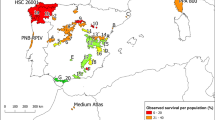Summary
Young Panolis flammea (Lepidoptera: Noctuidae) larvae were unable to survive on the mature (one-year old) needles of Pinus contorta and Pinus sylvestris. Larval growth and survival on the current year's shoots of the 2 pine host plants first incresed, and then decreased as pine shoot development progressed, the effect on survival being more marked at 10° C that 18° C. The survival of larvae on lodgepole pine on field-grown plants transferred to 10° C rose from 26% in March to 87% in mid May, and rose from 3% to 82% on Scots pine in the same period. Larval survival exceeded 70% for about 8 weeks on lodgepole pine and about 6 weeks on Scots pine, this period starting and ending earlier on lodgepole than on Scots pine. The nitrogen, water and phosphorus contents of both pines were at a maximum in May and decline gradually thereafter; the soluble tannin content showed a more complex pattern. These results are discussed in relation to the possible importance of phenological coincidence on the population dynamics of P. flammea with emphasis on its greater abundance on lodgepole pine in Scotland.
Similar content being viewed by others
References
Allen SE, Grimshaw M, Parkinson JR, Quarmby C (1974) Chemical analysis of ecological methods. Blackwell, Oxford
Barbour DA (1987) Pine beauty moth population dynamics: general considerations and the life table work. In: Leather SR, Stoakley JT, Evans HF (eds) Population biology and control of the Pine Beauty Moth (Panolis flammea) Forestry Commission Research and Development Paper, Edinburgh (in press)
Bernays EA (1981) Plant tannins and insect hervivores: an appraisal. Ecol Ent 6:353–360
Day KR (1976) An ecological study of Zeiraphera diniana Gn (= griseana Hb.) on conifers in Britain. Unpublished Ph D thesis, University of London
Du Merle P (1983) Phénologies comparées du chêne pubescent, du chêne vert et de Tortrix viridana L. (Lep., Tortricidae). Mise en évidence chez l'insecte de deux populations sympatriques adaptées chacune à l'un des chênes. Acta Oecol Oecol Appl 4:55–74
Feeny P (1970) Seasonal changes in oak leaf tannins and nutrients as a cause of spring by winter moth caterpillars. Ecology 51:565–581
Feeny PP (1976) Plant apparency and chemical defense. Recent Adv Phytochem 19:1–40
Gibson IAS, Jones T (1977) Monocultures as the origin of major fores pests and diseases. In: Cherret JM, Sagar GR (eds) Origins of pest, parasite, disease and weed problems. Blackwell, Oxford, pp 139–161
Haukioja E (1980) On the role of plant defences in the fluctuation of herbivore populations. Oikos 35:202–213
Leather SR (1985) Oviposition preferences in relation to larval growth rates and survival in the pine beauty moth, Panolis flammea. Ecol Ent 10:213–217
Mattson WJ (1980) Herbivory in relation to plant nitrogen content. Ann Rev Ecol Syst 11:119–161
Radford PJ (1967) Growth analysis formulae, their use and abuse. Crop Science 7:171–175
Raup MJ, Denno RF (1983) Leaf age as a predictor of herbivore distribution and abundance. In: Denno RF, McClure MS (eds) Variable plants and herbivores in natural and managed systems. Academic Press, London, pp 91–124
Rhoades DF (1983) Herbivore population dynamics and plant chemistry. In: Denno RF, McClure MS (eds) Variable plants and herbivores in natural and managed systems. Academic Press, London, pp 155–220
Schweizer DF (1979) Effects of foliage age on body weight and survival in larvae of the tribe Lithophanini (Lepidoptera: Noctuidae). Oikos 32:403–408
Scriber JM, Slansky F (1981) The nutritional ecology of immature insects. Ann Rev Ent 26:183–211
Stoakley JT (1977) A severe outbreak of the pine beauty moth on lodgepole pine in Sutherland. Scott For 31:113–125
Stoakley JT (1986) Protecting the timber resource In: Jenkins D (ed) Trees and wildlife in the Scottish Uplands. Institute of Terrestrial Ecology, Abbots Ripton, Huntingdon, pp 108–111
Thomson AJ (1979) Evaluation of key biological relationships of western budworm and its host trees. Environment Canada Forestry Service Pacific Forest Research Centre Report BC-X-186
Watt AD (1979) The effect of cereal growth stages on the reproductive activity of Sitobion avenae and Metopolophium dirhodum. Ann Appl Biol 91:147–157
Watt AD (1986a) The ecology of the pine beauty moth in commercial woods in Scotland. In: Jenkins D (ed) Trees and Wildlife in the Scottish Uplands. Institute of Terrestrial Ecology, Abbots Ripton, Huntingdon, pp 79–87
Watt AD (1986b) The performance of the pine beauty moth on water-stressed lodgepole pine plants: a laboratory experiment. Oecologia (Berlin) 70:578–579
Watt AD, Leather SR (1987) The pine beauty moth in Scottish lodgepole pine plantations. In: Berryman AA (ed) Insects in Forest Ecosystems: Enquiries into the Causes of Outbreaks. Plenum Press (in press)
Author information
Authors and Affiliations
Rights and permissions
About this article
Cite this article
Watt, A.D. The effect of shoot growth stage of Pinus contorta and Pinus sylvestris on the growth and survival of Panolis flammea larvae. Oecologia 72, 429–433 (1987). https://doi.org/10.1007/BF00377575
Received:
Issue Date:
DOI: https://doi.org/10.1007/BF00377575




